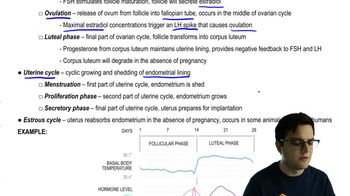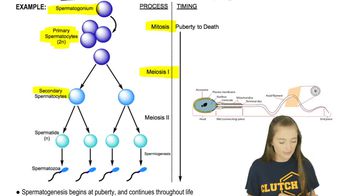Table of contents
- 1. Introduction to Biology2h 40m
- 2. Chemistry3h 40m
- 3. Water1h 26m
- 4. Biomolecules2h 23m
- 5. Cell Components2h 26m
- 6. The Membrane2h 31m
- 7. Energy and Metabolism2h 0m
- 8. Respiration2h 40m
- 9. Photosynthesis2h 49m
- 10. Cell Signaling59m
- 11. Cell Division2h 47m
- 12. Meiosis2h 0m
- 13. Mendelian Genetics4h 41m
- Introduction to Mendel's Experiments7m
- Genotype vs. Phenotype17m
- Punnett Squares13m
- Mendel's Experiments26m
- Mendel's Laws18m
- Monohybrid Crosses16m
- Test Crosses14m
- Dihybrid Crosses20m
- Punnett Square Probability26m
- Incomplete Dominance vs. Codominance20m
- Epistasis7m
- Non-Mendelian Genetics12m
- Pedigrees6m
- Autosomal Inheritance21m
- Sex-Linked Inheritance43m
- X-Inactivation9m
- 14. DNA Synthesis2h 27m
- 15. Gene Expression3h 20m
- 16. Regulation of Expression3h 31m
- Introduction to Regulation of Gene Expression13m
- Prokaryotic Gene Regulation via Operons27m
- The Lac Operon21m
- Glucose's Impact on Lac Operon25m
- The Trp Operon20m
- Review of the Lac Operon & Trp Operon11m
- Introduction to Eukaryotic Gene Regulation9m
- Eukaryotic Chromatin Modifications16m
- Eukaryotic Transcriptional Control22m
- Eukaryotic Post-Transcriptional Regulation28m
- Eukaryotic Post-Translational Regulation13m
- 17. Viruses37m
- 18. Biotechnology2h 58m
- 19. Genomics17m
- 20. Development1h 5m
- 21. Evolution3h 1m
- 22. Evolution of Populations3h 52m
- 23. Speciation1h 37m
- 24. History of Life on Earth2h 6m
- 25. Phylogeny2h 31m
- 26. Prokaryotes4h 59m
- 27. Protists1h 12m
- 28. Plants1h 22m
- 29. Fungi36m
- 30. Overview of Animals34m
- 31. Invertebrates1h 2m
- 32. Vertebrates50m
- 33. Plant Anatomy1h 3m
- 34. Vascular Plant Transport2m
- 35. Soil37m
- 36. Plant Reproduction47m
- 37. Plant Sensation and Response1h 9m
- 38. Animal Form and Function1h 19m
- 39. Digestive System10m
- 40. Circulatory System1h 57m
- 41. Immune System1h 12m
- 42. Osmoregulation and Excretion50m
- 43. Endocrine System4m
- 44. Animal Reproduction2m
- 45. Nervous System55m
- 46. Sensory Systems46m
- 47. Muscle Systems23m
- 48. Ecology3h 11m
- Introduction to Ecology20m
- Biogeography14m
- Earth's Climate Patterns50m
- Introduction to Terrestrial Biomes10m
- Terrestrial Biomes: Near Equator13m
- Terrestrial Biomes: Temperate Regions10m
- Terrestrial Biomes: Northern Regions15m
- Introduction to Aquatic Biomes27m
- Freshwater Aquatic Biomes14m
- Marine Aquatic Biomes13m
- 49. Animal Behavior28m
- 50. Population Ecology3h 41m
- Introduction to Population Ecology28m
- Population Sampling Methods23m
- Life History12m
- Population Demography17m
- Factors Limiting Population Growth14m
- Introduction to Population Growth Models22m
- Linear Population Growth6m
- Exponential Population Growth29m
- Logistic Population Growth32m
- r/K Selection10m
- The Human Population22m
- 51. Community Ecology2h 46m
- Introduction to Community Ecology2m
- Introduction to Community Interactions9m
- Community Interactions: Competition (-/-)38m
- Community Interactions: Exploitation (+/-)23m
- Community Interactions: Mutualism (+/+) & Commensalism (+/0)9m
- Community Structure35m
- Community Dynamics26m
- Geographic Impact on Communities21m
- 52. Ecosystems2h 36m
- 53. Conservation Biology24m
44. Animal Reproduction
Animal Reproduction
Problem 5a
Textbook Question
An egg cell that is not fertilized follows which path? a. ovary, oviduct, uterus, cervix; b. ovary, uterus, oviduct, cervix; c. oviduct, ovary, cervix, uterus; d. oviduct, ovary, uterus, cervix; e. ovary, oviduct, cervix, uterus
 Verified step by step guidance
Verified step by step guidance1
Identify the starting point of the egg cell, which is the ovary where eggs are produced.
Determine the next location the egg travels to after the ovary. In the female reproductive system, the egg moves into the oviduct (also known as the fallopian tube) where fertilization typically occurs.
After passing through the oviduct, the egg, if not fertilized, continues its path to the uterus. The uterus is where a fertilized egg would normally implant and develop.
Consider the role of the cervix, which is the lower part of the uterus that opens into the vagina. The cervix does not play a direct role in the path of an unfertilized egg as it travels through the reproductive system.
Using the information from the previous steps, choose the option that correctly lists the path of an unfertilized egg: ovary, oviduct, uterus, cervix.
Recommended similar problem, with video answer:
 Verified Solution
Verified SolutionThis video solution was recommended by our tutors as helpful for the problem above
Video duration:
44sPlay a video:
Was this helpful?
Key Concepts
Here are the essential concepts you must grasp in order to answer the question correctly.
Ovarian Cycle
The ovarian cycle involves the maturation of egg cells (oocytes) within the ovaries. Each month, a follicle develops and releases an egg during ovulation. If the egg is not fertilized, it will not proceed through the reproductive tract, making understanding this cycle essential for answering the question.
Recommended video:
Guided course

Krebs Cycle
Reproductive Tract Pathway
The reproductive tract pathway describes the route an egg cell takes through the female reproductive system. After ovulation, if the egg is not fertilized, it typically moves from the ovary to the oviduct, but it will not continue to the uterus, cervix, or vagina, which is crucial for determining the correct answer.
Recommended video:
Guided course

Digestion and Digestive Tracts
Menstrual Cycle
The menstrual cycle is the monthly series of changes in the female reproductive system, including the preparation of the uterus for potential pregnancy. If fertilization does not occur, the egg disintegrates, and the cycle continues, highlighting the importance of understanding the timing and pathways involved in egg transport.
Recommended video:
Guided course

Menstrual Cycle

 5:44m
5:44mWatch next
Master Sexual and Asexual Reproduction with a bite sized video explanation from Jason Amores Sumpter
Start learningRelated Videos
Related Practice


































































